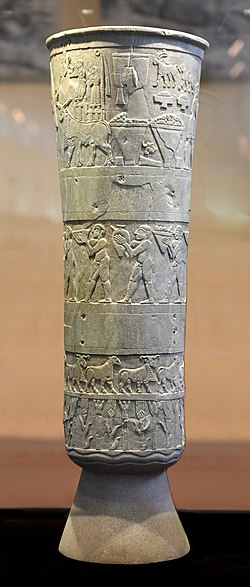Loading AI tools
Carved alabaster vessel, from Sumerian temple, Uruk (Warka), Iraq From Wikipedia, the free encyclopedia
The Warka Vase or Uruk vase is a slim carved alabaster vessel found in the temple complex of the Sumerian goddess Inanna in the ruins of the ancient city of Uruk, located in the modern Al Muthanna Governorate, in southern Iraq. Like the Uruk Trough and the Narmer Palette from Egypt, it is one of the earliest surviving works of narrative relief sculpture, dated to c. 3200–3000 BC.[1] Simple relief sculpture is also known from much earlier periods, from the site of Göbekli Tepe, dating to circa 9000 BC.
| Warka Vase | |
|---|---|
 The original Warka Vase, dated to c. 3200–3000 BC. National Museum of Iraq, March 2019. | |
| Material | Alabaster |
| Created | c.3200–3000 BC |
| Present location | Iraq Museum, Iraq |
The bottom register displays naturalistic components of life, including water and plants, such as date palm, barley, and wheat. On the upper portion of the lowest register, alternating rams and ewes march in a single file. The middle register conveys naked men carrying baskets of foodstuffs symbolizing offerings. Lastly, the top register depicts the goddess Inanna accepting a votive offer.[2] Inanna stands at the front portion of the gate surrounded by her richly filled shrine and storehouse (identifiable by two reed door poles with dangling banners). This scene may illustrate a reproduction of the ritual marriage between the goddess and Dumuzi, her consort that ensures Uruk's continued vitality.[2] The vase depicts an example of hierarchy being a portion of nature, and, according to anthropologist Susan Pollock, shows that social and natural hierarchies were most likely akin to each other in ancient Mesopotamia.[3]
The vase was discovered as a collection of fragments by German Assyriologists in their sixth excavation season at Uruk in 1933/1934. The find was recorded as find number W14873 in the expedition's field book under an entry dated 2 January 1934, which read "Großes Gefäß aus Alabaster, ca. 96 cm hoch mit Flachrelief" ("large container of alabaster, circa 96 cm high with flat-reliefs").[4] The vase, which showed signs of being repaired in antiquity, stood 3 feet 1⁄4 inch (0.921 m) tall.[1] Other sources cite it as having been a slightly taller 106 cm, with an upper diameter of 36 cm.[5][6] It is named after the modern village of Warka – known as Uruk to the ancient Sumerians. A plaster cast was made of the original and this reproduction stood for many decades in room 5 of the Near-Eastern Museum in Berlin (Vorderasiatisches Museum Berlin), Germany.[5]
The vase has three registers – or tiers – of carving. The bottom register depicts the vegetation in the Tigris and Euphrates delta, such as the natural reeds and cultivated grain. Above this vegetation is a procession of animals, such as ram and sheep presented in a strict profile view. The procession continues in the second register with nude males carrying bowls and jars of sacrificial elements, such as fruit and grain. The top register is a full scene, rather than a continuous pattern. In this register, the procession ends at the temple area. Inanna, one of the chief goddesses of Mesopotamia and later known as Ishtar in the Akkadian pantheon, stands, signified by two bundles of reeds behind her. She is being offered a bowl of fruit and grain by a nude figure. The en of Uruk dressed in a ceremonial kilt and long belt faces her leading the procession.[7]

The Warka Vase was one of the thousands of artifacts which were looted from the National Museum of Iraq during the 2003 Invasion of Iraq. In April 2003,[6] it was forcibly wrenched from the case where it was mounted, snapping at the base (the foot of the vase remaining attached to the base of the smashed display case.[8]
The vase was later returned during an amnesty to the Iraq Museum on 12 June 2003 by three unidentified men in their early twenties, driving a red Toyota vehicle. As reported by a correspondent for The Times newspaper,
As they struggled to lift a large object wrapped in a blanket out of the boot, the American guards on the gate raised their weapons. For a moment, a priceless 5,000-year-old vase thought to have been lost in looting after the fall of Baghdad seemed about to meet its end. But one of the men peeled back the blanket to reveal carved alabaster pieces that were clearly something extraordinary. Three feet high and weighing 600 lb intact, this was the Sacred Vase of Warka, regarded by experts as one of the most precious of all the treasures taken during looting that shocked the world in the chaos following the fall of Baghdad. Broken in antiquity and stuck together, it was once again in pieces.[9]
Soon after the vase's return, broken into 14 pieces,[10] it was announced that the vase would be restored.[11] A pair of comparison photographs, released by the Oriental Institute, Chicago, showed significant damage (as of the day of return, 12 June 2003) to the top and bottom of the vessel.[12]
The fully restored Warka Vase (museum number IM19606)[6] is now on display in the Iraq Museum.
Seamless Wikipedia browsing. On steroids.
Every time you click a link to Wikipedia, Wiktionary or Wikiquote in your browser's search results, it will show the modern Wikiwand interface.
Wikiwand extension is a five stars, simple, with minimum permission required to keep your browsing private, safe and transparent.